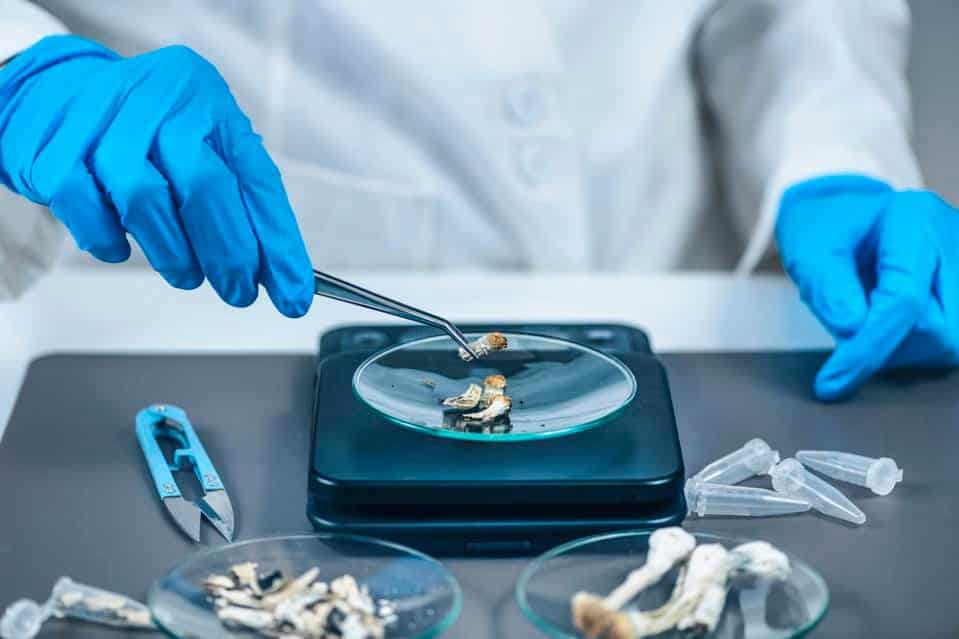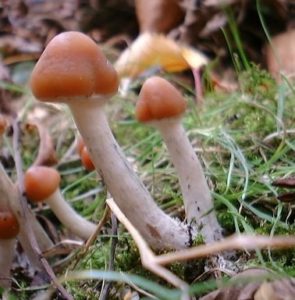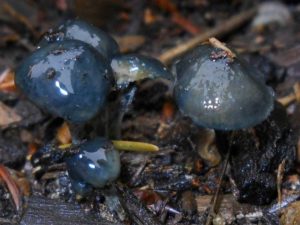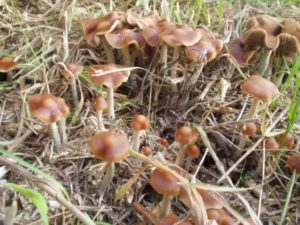
Understanding and Measuring Magic Mushroom Potency
A common question about magic mushrooms is how potent are they? While you won’t be measuring magic mushroom potency at home, the understanding of measuring magic mushroom potency is critical to your experience.
Table of Contents
What Makes Magic Mushrooms Potent
The potency of magic mushrooms is based on two main components:
- The chemical constituents of magic mushrooms
- Brain chemistry and dosage
The Chemical Constituents of Magic Mushrooms
Magic mushrooms species are wild or cultivated mushrooms that contain psilocybin, a naturally-occurring psychoactive and hallucinogenic compound. Most of these mushrooms have 4 psychoactive chemicals in some combination. These chemicals include:
- Psilocybin (4-phosphoryloxy-N,N-dimethyltryptamine): The main psychoactive principle of hallucinogenic mushrooms. After ingestion, psilocybin is converted into the pharmacologically active form psilocin. Psilocin itself is also present in the mushroom, but in smaller amounts. Psilocybin and psilocin are both indolealkylamines and structurally similar to the neurotransmitter serotonin (5-hydroxytryptamine or 5-HT). Psilocybin (psilocybine, psilocibina, psilocybinum, psylosybiini) is 4-phosphoryloxy-NN-dimethyltryptamine. According to IUPAC, the fully systematic chemical name is [3-(2-dimethylaminoethyl)-1H-indol-4-yl] dihydrogen phosphate. Psilocybin is the dihydrogen phospate of psilocin. Psilocybin is soluble in water, moderately soluble in methanol and ethanol, and insoluble in most organic solvents. Psilocybin is a prodrug of psilocin, in vivo the molecule is metabolised into psilocin by dephosphorylation.
- Psilocin (4-hydroxy-N,N-dimethyltryptamine): Known as either 4-hydroxy-NN-dimethyltryptamine (4-OH-DMT) or alternatively 3-(2-dimethylaminoethyl)indol-4-ol. According to IUPAC, the fully systematic chemical name is 3-(2-dimethylaminoethyl)-1H-indol-4-ol. Psilocin is an isomer of bufotenine, it differs only in the position of the hydroxylgroup. Psilocin is relatively unstable in solution. Under alkaline conditions in the presence of oxygen it immediately forms bluish and black degradation products.
- Baeocystin (4-phosphoryloxy-N-methyltryptamine)
- Norbaeocystin (4-phosphoryloxytryptamine)
As you will see later in this article, the average amounts of these chemical compound varies average amounts of these chemical compound varies with a number of factors including:
- The measurement technique itself
- Mushroom species
- Growing environment
Brain Chemistry and Dosage
Individual brain chemistry, psychological predisposition as well as mushroom age and storage method, which impact the psilocybin content of a given sample of mushrooms, play a significant role in determining the impact of any given dose of dried mushrooms containing psilocybin:
- For a few rare people, doses as small as 0.25 gram can produce full-blown effects normally associated with very high doses. For most people, however, that dose level would result in virtually no effects.
- 0.25–1 gram is usually sufficient to produce a mild effect,
- 1–2.5 grams usually provides a moderate effect,
- 2.5 grams and higher usually produces strong effects. For most people, 3.5 dried grams (1/8 oz) would be considered a high dose and may produce an intense experience; this is, however, typically considered a standard dose among recreational users.
- For many individuals, doses above three grams may be overwhelming.
Psilocin mainly interacts with 5-HT1A, 5-HT2A and 5-HT2C receptor subtypes: it is a mixed receptor agonist but does not have an effect on the dopamine receptor.
While we have said it before, we will say it again, “It is not recommended to eat wild mushrooms without properly identifying them as they may be poisonous. Species similar to the psychedelic species include mushrooms of the genus Galerina, Pholiotina rugos and Chlorophyllum molybditesall, all of which are potentially deadly and grow in pastures—similar habitat to that preferred by P. cubensis“.
Related Articles
Learn more about Psilocybin on Frshminds:
- Considering a retreat? Check out Frshminds’ Ultimate Psilocybin Retreat Center Guide.
- What Kind of a Drug is Psilocybin? What Will It Do To Me?
- How Long Does Psilocybin Stay in Your System?
- Don’t Miss the Best Psilocybin Retreats in Amsterdam
- How To Properly Store Magic Mushrooms
- Why Are There Psilocybin Retreats In Mexico?
- Want To Go To A Magic Mushroom Retreat in Jamaica?
- 3 Top-Rated Psilocybin Retreats in Costa Rica
- The Best Psilocybin Retreats: What To Look For
- Psilocybin Retreats in the Netherlands
How Do You Measure Magic Mushroom Potency
Over the last few decades, researchers have attempted to measure the potency of magic mushrooms via both extraction techniques and high performance liquid chromatography.
You might be asking yourself why any of this matter and the simple answer is the efficiency of the method used to measure the psilocybin content, either a solvent extraction technique or liquid chromatography, will show different levels of pharmacologically active components in mushrooms, so you could over or underestimate the strength of any given mushroom species.
Measuring Magic Mushroom Potency: Extraction Techniques
Extraction in chemistry is a separation process consisting of the separation of a substance from a matrix. Without getting into too much lab geek speak, Liquid-Liquid extraction is a method by which a compound, in this case psilocybin, is pulled from one non miscible solvent A to another. Miscibility refers to solvents which do not mix in all proportions to form a homogeneous mixture For example, water and ethanol are miscible because they mix in all proportions.
Extraction methods differ depending upon the density of the solvent being used. Solvents more dense than water will require different glassware (or supplemental glassware) vs. solvents that are less dense than water. Researchers have used a number of solvents to measure psilocybin content
Different Extraction Techniques and Magic Mushroom Potency
The tables below show the total amount of psilocybin, psilocin and baeocystin extracted from a number of species with different types of solvents. What you will see is that different techniques revealed different concentrations of this substance:
- The pure methanol for extraction of the mushrooms analysis revealed the highest concentrations of psilocybin and baeocystin.
- The psilocin content of the species was higher by using aqueous solutions of alcohols than with methanol alone but was an artificial phenomenon caused by enzymatic destruction of psilocybin.
- The extraction with dilute acetic acid yielded better results than with the water containing alcohols.
| Species | Psilocybin | Psilocin | Baeocystin |
|---|---|---|---|
| P. semilanceata | 0.98 | – | 0.34 |
| P. bohemica | 0.85 | 0.02 | 0.04 |
| P. bohemica (cultivated) | 0.93 | 0.04 | 0.02 |
| P. cubensis | 0.63 | 0.11 | 0.02 |
| G. purpuratus | 0.34 | 0.29 | 0.05 |
| I. aeruginacens | 0.40 | – | 0.21 |
| P. cyanescens | 0.32 | 0.51 | 0.02 |
| Species | Psilocybin | Psilocin | Baecystin |
|---|---|---|---|
| P. semilanceata | 0.97 | 0.15 | 0.11 |
| P. bohemica | 0.60 | 0.21 | – |
| P. bohemica (cultivated) | 0.65 | 0.28 | – |
| P. cubensis | 0.45 | 0.25 | – |
| G. purpuratus | 0.24 | 0.35 | 0.01 |
| I. aeruginacens | 0.32 | 0.05 | 0.15 |
| P. cyanescens | 0.20 | 0.61 | – |
| Species | Psilocybin | Psilocin | Baeocystin |
|---|---|---|---|
| P. semilanceata | 0.80 | 0.15 | 0.11 |
| P. bohemica | 0.60 | 0.21 | – |
| P. bohemica (cultivated) | 0.65 | 0.28 | – |
| P. cubensis | 0.45 | 0.25 | – |
| G. purpuratus | 0.24 | 0.35 | 0.01 |
| I. aeruginacens | 0.32 | 0.05 | 0.15 |
| P. cyanescens | 0.20 | 0.61 | – |
Measuring Magic Mushroom Potency: Liquid Chromatography
High-performance liquid chromatography separates, identifies, and quantifies the different components in a mixture, using pumps to pass a pressurized liquid solvent containing the sample mixture through a column filled with a solid adsorbent material.
Liquid chromatography works because each component in the sample interacts slightly differently with the adsorbent material, causing different flow rates for the different components and leading to the separation of the components as they flow out of the column.
The concentrations of psilocin and psilocybin, as a percentage of dry weight. are in the ranges of:
- 0.14–0.42% and 0.37–1.30% (dry weight) in the whole mushroom
- 0.17–0.78% and 0.44–1.35% in the cap
- 0.09 and 0.30%/0.05–1.27% in the stem
What Are The Strongest Magic Mushrooms?
Once you’ve consumed magic mushrooms a few times, a frequent question that comes is, “What is the strongest magic mushroom”? We’ve decided to answer this question in two ways, looking at some older literature as well as some recently conducted testing.
Historic Magic Mushroom Potency Scale
Historically, the data in the table below, aggregated by Paul Stamets in “Psilocybin Mushrooms of the World: An Identification Guide“, has been accepted as the defining magic mushroom potency scale.
The takeaway from this research is that while most magic mushroom users are familiar with Psilocybe Cubensis, there are species which are much stronger (like 3x strong based on % of psilocybin as dry body weight)
| SPECIES | % PSILOCYBIN | % PSILOCIN | % BAEOCYSTIN | REFERENCE |
|---|---|---|---|---|
| P. azurenscens | 1.78 | .38 | .35 | Stamets and Gartz 1995 |
| P. bohemica | 1.34 | .11 | .02 | Gartz and Muller 1989; Gartz (1994) |
| P. semilanceata | .98 | .02 | .36 | Gartz 1994 |
| P. baeocystis | .85 | .59 | .10 | Repke et al. 1977; Beug and Bigwood 1982(b) |
| P. cyanescens | .85 | .36 | .03 | Stijve and Kuyper 1985; Repke et al. 1977 |
| P. tampanensis | .68 | .32 | n/a | Gartz 1994 |
| P. cubensis | .63 | .60 | .025 | Gartz 1994; Stijve and de Meijer 1993 |
| P. weilii | .61 | .27 | .05 | |
| P. hoogshagenii | .60 | .10 | n/a | Heim and Hofmann 1958 |
| P. stuntzii | .36 | .12 | .02 | Beug and Bigwood 1982(b); Repke et al. 1977 |
| P. cyanofibrillosa | .21 | .04 | n/a | Stamets et al. 1980 |
| P. liniformans | .16 | n/d | .005 | Stijve and Kuyper |
Psilocybe Azurescens Psilocybin Potency

Psilocybe azurescens, first identified and named by Paul Stamets, is by the strongest magic mushroom species (Three times more powerful than Cubensis like b+ or Golden Teachers). Psilocybe azurescens gained notoriety after a wild patch was sampled by some Boy Scouts on a camping trip in 1979.
Azurescens are rare and generally found only on the West coast of the U.S. from Southern California to Northern Washington, clustering on or near the Columbia River delta in Oregon.
They grow in soils that are sandy in composition and clump together in/ around dunes, and are often to be found on rotting or decaying wood.
The Psilocybe azurescens species of magic mushrooms are also known by a variety of other names, including:
- Flying Saucers: The large cap is unique in its UFO shape and can grow up to 100mm in diameter.
- Blue Angels
- Blue Runners
- Azzies
They are light to dark brown in color and may begin to show dark blue or black pitted marks as they age.
Psilocybe Bohemica Psilocybin Potency

Psilocybe bohemica is found in five different parts of the Czech Republic. Psilocybin levels in this species were found to vary between 0.11% up to 1.34% by dry weight. The content of baeocystin and psilocybin was highest in the caps of the mushrooms.
Molecular analysis has shown that P. serbica is the same species as Psilocybe bohemica, Psilocybe arcana and Psilocybe moravica.
Psilocybe Semilanceata Psilocybin Potency

Psilocybe semilanceata (often called Liberty caps or Witch’s Hats due to their unusual pointy shaped, conical crown) grows in grassland habitats and wetter environments with lots decaying roots. Psilocybe semilanceata, also commonly known as Liberty Caps, is one of the world’s most widespread naturally growing magic mushroom varieties, is found in Switzerland, Poland, Netherlands, US, Canada, and Russia.
Psilocybe semilanceata, first identified in 1838 and became one of the first psilocybin-containing mushrooms to be formally recognized for its psychoactive properties, is considered the third most potent with 0.98% psilocybin contained within their stalks and caps.
While they grow wild across most of the Northern Hemisphere, including Germany, France, Italy, Bulgaria, Iceland, Finland, Russia, and Turkey, they can also be found in North America on the West Coast from California all the way up to British Columbia during the Autumn or early winter months, and in lesser proportions on the East Coast from Newfoundland to the cold wilds of Nova Scotia in Canada.
The preferred growing spot of Liberty Caps is in rich, acidic soil that has been heavily fertilized by cow manure or sheep dung and is often found growing in meadows, grasslands, pastures, and sometimes even on or around lawns.
Liberty caps are one of the smallest varieties of magic mushrooms and are easily overlooked as they can blend into the foliage and grass cover. They are 40mm to 100mm in stem size (1.5 inches to 4 inches long) and have a bell-shaped or conical cap, hence the Witches Hat resemblance.
Psilocybe Baeocystis Psilocybin Potency

Psilocybe baeocystis, known as bottle caps, knobby tops, blue bells, olive caps, is a solitary mushroom that grows scattered on bark, peat moss, wood chips, and decaying conifer mulch.
Psilocybe baeocystis grows in pastures and in lawns in the Pacific Southwest. It has an average psilocybin content of up to 0.85%.
Psilocybe Cyanescens Psilocybin Potency

Psilocybe Cyanescens, Wavy Caps, are considered the third most common magic mushroom after p. cubensis and azurescens and were first found and identified for their psychoactive properties in England in 1946. Psilocybe Cyanescens’ psilocybin content varies from 0.66% – 1.96% and is one of the few varieties that are stronger when eaten fresh than dried. They are probably the most widespread psilocybin-containing mushrooms growing wild in the world and are native to most of the Pacific Northwest and Central Europe due to the availability of decaying wood environments.
Measuring Magic Mushroom Potency: The Psilocybin Cup
While there is a smattering of older scientific works, a new ongoing competition, The Psilocybin Cup, organized by Oakland Hyphae, is looking to update our collective appreciation of understanding and measuring magic mushroom potency. The Psilocybin Cup is a potency competition in which cultivators from around the world submit psilocybin-containing mushrooms for laboratory testing and analysis. Hyphae Labs analyzed mushroom samples from over 50 growers and announced the test results (pdf document download if you want to read the whole thing).
As you can see from the table below, the amount of psilocybin and psilocin are higher than previously reported, and a good portion of the powerful entrants are related to Penis Envy, a psilocybe cubensis species:

As with previous research, Psilocybin Cup potency tests demonstrate that the active hallucinogenic compounds in magic mushrooms, psilocin and psilocybin, vary widely across cultivars and species.
Strongest Magic Mushroom Species
Given what we know about the variability in the measurement and actual chemical composition of any given magic mushroom species, it is particularly difficult to say with certainty what is the strongest magic mushroom species.
While one can make certain generalizations about relative species strength, it is tantamount to speculation.
Conclusion: Understanding and Measuring Magic Mushroom Potency
The takeaway lesson from this article is that simply measuring a dose of magic mushrooms of a given species by weight does not guarantee the same effect every time. Variations in growing and drying techniques, environment, brain chemistry and age are just a few of the variables that can affect mushroom potency.
Read More About The Science of Psychedelics and Pain
- Psilocybin Pain Resources: Scientists And Sufferers Have Their Say
- Psychedelics And Chronic Pain: What Do We Know
- Magic Mushrooms For Pain Relief
- Can Psilocybin Help With Pain?
- What Happens In Your Brain When You Take Psilocybin?
- How Long Does Psilocybin Stay in Your System?
Magic Mushrooms 101
If you are looking to get up to speed on magic mushrooms, these articles on Frshminds will get you there in no time:
References
Hallucinogenic mushrooms drug profile: European Monitoring Centre for Drugs and Drug Addiction (EMCDDA)
Morphological and chemical analysis of magic mushrooms in Japan: Forensic Sci Int. 2003 Dec 17;138(1-3):85-90. doi: 10.1016/j.forsciint.2003.08.009.
The psilometric scale of comparative potency of selected Psilocybe mushrooms
Gartz, Jochen. “Extraction and analysis of indole derivatives from fungal biomass” Journal of Basic Microbiology Vol 34, 1994; 17-22
Chemical Composition Variability in Magic Mushrooms
Liquid-Liquid Extraction
Stivje, de Meijer. “Macromycetes from the state of Parana, Brazil. 4 The psychoactive species” Arq Biol Technol 1993 36(2):313-329
Gartz and Muller. “analyses and cultivation of fruitbodies and mycelia of Psilocybe bohemica.” Biochem Physiol Pflanzen. 1989. 184:337-341
Stamets and Gartz. “a new caerulescent Psilocybe from the Pacitic Coast of Northwestern North America”. Integration 6. 1995
Repke D, Leslie D, Guzman G. “Baeocystin in Psilocybie, Conocybe, and Panaeolus.” LLoydia. 1977. 40:566-578
Beug M, Bigwood J. “Quantitative analysis of psilocybin and psilocin in Psilocybe baeocystic Singer and Smith by high-performance liquid chromatography and by thin-layer chromatography.” Journal of Chromatography 1981 207:370-385.
Beug M, Bigwood J. “Variation of psilocybin and psilocin levels with repeated flushes (harvests) of mature sporocaps of Psilocybe cubensis (earle) Singer.” Journal of Ethnopharmacology 1982. 5:271-291.
Beug M, Bigwood J. “Psilocybin and psilocin levels in twenty species from seven genera of wild mushrooms in the Pacific Northwest (USA)” Journal of Ethnopharmacology 1982. 5:271-278.
Stivje TC, Kuyper TW. “Occurence of psilocybin in various higher fungi from several European countries” Planta Medica 1985 51(5):385-387.
Heim RA, Hofmann A. “La psilocybine et la psilocine chez les psilocybe et strophaires hallucinogenes.” Les champignons hallucinogenes du Mexique. 1958. 6:258-267. Paris: Editions du Museum National d’Histoire Naturelle.
Stamets P, Beug PM, Bigwood J, Guzman G. “a new species and a new variety of Psilocybe from North America” Mycotaxon 1980 11:476-484.

Comments